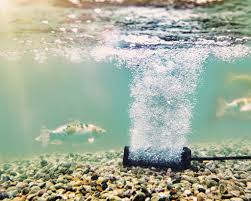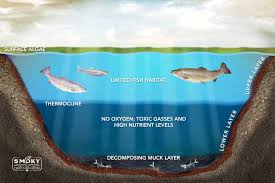In order to know if the oxygen level of the water in your fish pond is enough for the fishes, you need to observe your pond every morning and evening only then you will know the oxygen level on your fish pond.
If early in the morning and late in the evening, the water in your pond is full of s lot of air bubbles, then the oxygen level is low and it is most likely that there is immediate need for you to change the water and pump in fresh water.
Oxygen is responsible for a great amount of natural and biological processes; thus, it is essential for all life. If you have a fish pond, your fish will need oxygen to survive. Fish, much like mammals, absorb oxygen into their bloodstreams and tissues to be used in important cell functions.
In fact, even bacteria need to ‘breath’ oxygen. Within pond water, oxygen is needed to enable aerobic bacteria to break down natural organics.
Without this fundamental process of decomposition, pond owners might experience problems such as the inefficient breakdown of sludge causing organics.
However, the biggest problem with low oxygen levels in a pond is the unhealthy water quality environment for aquatic life.

Causes of Low Pond Oxygen Levels
Various factors can contribute to low pond oxygen levels. The most common cause is often a combination of high pond water temperatures and algae. Whether we’re talking ponds or not, dissolved oxygen levels are naturally lower when water temperatures are higher. Therefore, in summer, ponds also have low oxygen levels.
The problem is that summer brings with it a combination of sunshine and increased organic nutrients that encourage algae to grow. As a plant form, algae are known to produce oxygen.
However, during the night because of the lack of sunlight (to conduct photosynthesis and respire) algae consume the oxygen contents in the pond instead. Further reducing pond oxygen levels.
Read Also: How many plots of land do I need to start fish farming?
The Appropriate Amount of Pond Oxygen
As mentioned before, oxygen concentration levels in ponds are naturally low. Rarely will a pond have more then 10ppm (parts per million) dissolved oxygen concentrations in its water. Compared to an average 200,000ppm oxygen concentration in the atmosphere or air we breathe daily.
However, pond oxygen levels ranging between 2 to 3ppm are where concentrations truly become hazardous to pond life. Causing fish to become susceptible to stress and disease.
Most fish will start to become stressed when oxygen levels drop below 3ppm, while concentrations below 2ppm are deadly to some species. One of the most common signs of stress to look out for is fish gasping for air at the surface of the pond water.
Although it generally depends on the state and size of any individual pond, its best to have at least 6mg per litre of dissolved oxygen in any body of pond water. This ratio will keep pond oxygen levels well above the dangerously low ppm concentrations mentioned above.
How to Measure or Test Pond Oxygen Levels
It’s important to test oxygen concentrations to ensure you have healthy pond oxygen levels for fish to thrive, stress and disease free. While there are common signs that might indicate your pond having insufficient oxygen levels, we highly recommend using a specific dissolved oxygen test kit.
Follow the test kit’s precise instructions for accurate measurement of oxygen concentrations. Accurate measurements are important because if you remember, even a small drop in dissolved oxygen from 3ppm to 2ppm is there a difference between dangerous or deadly pond oxygen levels.
How to Increase Dissolved Oxygen Levels
Fortunately, there are various straightforward ways to either combat the depletion of or introduce more oxygen into a pond and prevent low oxygen levels. First, it’s important to understand how oxygen becomes dissolved in water.
Oxygen particles dissolve into the water simply by coming into contact with it. Therefore, to introduce more oxygen into a pond, there needs to be more water coming into contact with the oxygen in the atmosphere.
The surface of pond water is always in contact with the atmosphere and will, therefore, have the highest oxygen concentration. This explains why fish swim near the surface of a pond in times of oxygen shortage.
However, this also means that the majority of the water deeper within the pond does not have access to oxygen particles.
In order to increase the oxygen levels throughout the volume of pond water, you will need to increase the surface area that comes into contact with oxygen.
Read Also: Introduction to Fisheries / Classes of Fish
There are three main ways this can be achieved:
Increase Water Movement
Create movement in your pond by adding or turning on a water fountain or waterfall. Movement within a pond increases the surface area of water that comes into contact with oxygen.
Thus, more oxygen particles can dissolve into and concentrate the pond water. Ideally, the water fountain or waterfall would be at a good height to allow enough time for enough oxygen to be absorbed into the water as it falls into the pond.
Furthermore, the deeper the water splashes into a pond, the higher the droplets will bounce back. Giving the pond water even more opportunity to be exposed.
Add a Pond Air Pump
Another simple way to oxygenate pond water is to add a pond air pump. Air pumps help to introduce oxygen deep within the water. Pond keepers often mistake the bubbles generated from air pumps as the oxygen content themselves.
Rather the bubbles work to aerate the pond by encouraging movement and increased surface area exposed to oxygen.
Add Pond Oxygen Stones
Similar to and used alongside air pumps, pond oxygen stones also work by supplying air bubble into the water. Again, this increases pond water movement and surface area. Maximizing the potential for oxygen particles to dissolve into the water.
Read Also: Anatomy of Fishes: Female Fish and their Reproductive Strategies






